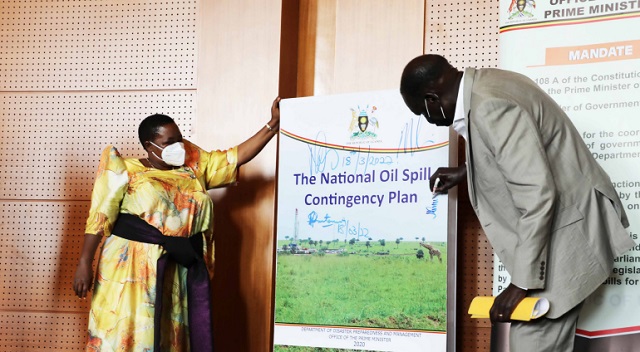
The east African nation hopes to start oil production in 2025
Kampala, Uganda | RONALD MUSOKE | Uganda finally launched its national oil spill contingency plan, detailing its preparedness to respond in the event of an oil spill. The East African nation hopes to produce its first oil in the first quarter of 2025.
An oil spill contingency plan is simply a detailed spill response and removal arrangement that addresses ‘control, containment and recovery of an oil discharge in quantities that may be harmful to navigable waters or adjoining shorelines,’ according to the US Environment Protection Agency (EPA).
The elements of an oil spill contingency plan, EPA notes, include; definition of the authorities, responsibilities, and duties of all entities involved in oil removal operations; procedures for early detection and timely notification of an oil discharge; assurance that full resource capability is known and can be committed following a discharge; actions for after discovery and notification of a discharge and procedures to facilitate recovery of damaged areas and enforcement measures.
Uganda’s oil spill contingency plan highlights the responsibility of licensees and operators for prevention of oil spills and the need for investing in preparedness for response to oil spills even if unlikely within the country’s territory and shared water bodies.
It provides for protection of human health and the environment from oil spills and clearly defines the three different tiers of preparedness or responses. It also establishes an effective and coordinated national oil spill preparedness and response system, including designating responsible institutions.
The plan further provides a system for collaboration on oil spill preparedness and response between licensees and operators, local governments and the central government, and also seeks international assistance when necessary. It also establishes an inventory system for oil spill response resources. This is in form of personnel and equipment, including training of personnel, drills and exercises.
The Petroleum Authority of Uganda (PAU) in partnership with the Office of the Prime Minister (OPM), and the National Environment Management Authority (NEMA) have been working together on the plan which was approved in February last year. It is premised on the internationally recognized “people, environment, assets and reputation” priority order (PEAR).
The PAU which is the lead agency responsible for management of oil spills, is now working with all the other agencies and communities to enhance their preparedness to handle oil spills at the different levels.
“Experience from around the world is that most countries put plans like this in place long after they have produced oil but also after undesirable incidents have occurred,” said Ernest Rubondo, the executive director of the PAU.
Rubondo said PAU has already initiated steps geared towards strengthening regulatory capacity in oil spill management that include equipping oil spill monitoring and incident command centres, facilitating the establishment oil spill response equipment hubs and undertaking specialized training in oil spill management.
Sigh of relief for conservationists?
The publication of the oil spill contingency plan will probably bring a sigh of relief to conservationists who for a long time have had reservations about the country’s oil project going ahead.
The licensed oil giants – TotalEnergies E& P Uganda Ltd and CNOOC Uganda Ltd – are currently ramping up activities in one of the areas known to have the most pristine environments in the oil rich mid-western Uganda to build oil production and transportation infrastructure.
Besides hosting some of the world’s rare animal and plant life, many of which are categorized as endangered by the International Union for Conservation of Nature (IUCN), the Albertine region which is estimated to have up to 6bn barrels of oil, also hosts a long stretch of the River Nile that is shared by Uganda, Rwanda, South Sudan, Tanzania, Burundi, Ethiopia, Kenya, DR Congo and Egypt.
One of the oil fields being developed is located inside Murchison Falls National Park while the others are located outside the park, south of the Victoria Nile. TotalEnergies’ License Areas I & II are in Buliisa and Nwoya districts, north of Lake Albert closer to the Uganda-DR Congo border. This area hosts six oil fields and is expected to have 400 wells which will be drilled in 31 locations. Its flagship project, Tilenga, which is expected to produce close to 190,000 barrels of crude oil per day, is located not far away from the Nile Delta in the Lake Albert region.
TotalEnergies’ other project, the East African Crude Oil Pipeline (EACOP) that consists of the construction of a buried 1,443km oil pipeline between the town of Kabaale in Uganda and the port of Tanga in Tanzania,traverses 10 districts, 22 sub-counties, four town councils, 41 parishes and over 170 villages in Uganda.
It moves southwards along the western side of Tanzania and continues to the southern end of Lake Victoria and turns east continuing across the western arm of the East African Rift Valley before terminating in the northern area of Tanga Port on the Indian Ocean Coast.
Meanwhile, Kingfisher, CNOOC’s flagship CPF project, is perched on the southeastern shores of Lake Albert in Buhuka Parish in Kikuube District. CNOOC which was the first international oil company to get an oil production licence from the government in 2013 is now expected to build infrastructure that will enable it extract up to 40,000 barrels of oil per day.
The Chinese firm that is claimed to be competent in developing offshore crude oil and natural gas projects has been tasked to establish myriad oil field facilities including a central processing facility (CPF), four well pads and 31 production and water injection wells.
CNOOC also intends to construct a 46km feeder pipeline that will move crude oil from its central processing facility in Buhuka to the delivery point at the proposed Kabaale Industrial Park in Hoima District.
Both international companies have on several occasions claimed that they are developing oil fields with utmost care for the environment and the people who live in the adjacent communities.
For instance, TotalEnergies has noted in the past that while its current permits cover nearly 10% of Murchison Fall National Park, the development will be restricted to an area representing less than 1% of its surface.
TotalEnergies has also noted that it has taken several measures in the Murchison Falls Park including limiting the number of wells to only 10, constructing underground oil and water injection lines, no processing facilities, no flares and installing horizontally drilled flow lines to cross River Nile.
In March, last year, TotalEnergies’ CEO, Patrick Pouyanné, noted in a statement that their aim is to limit Tilenga project’s footprint within Murchison Falls National Park in line with the “Avoid-Reduce-Compensate” principles that underpin its Biodiversity Policy published in 2020.
“We acknowledge Tilenga and EACOP projects represent significant social and environmental stakes, which we are taking into consideration responsibly,” TotalEnergies said in a statement published March 08, last year.
Chen Zhiobiao, the president of CNOOC Uganda Ltd also noted during the launch of the FID in February this year that his company will develop the Kingfisher Project in a sustainable manner. “CNOOC is a firm believer in being a responsible energy company. We spare no effort to protect the environment in every region we operate in,” he said. But conservationists have always remained cautious of what an oil spill could do to this sensitive environment.
Speaking during the launch of the oil spill contingency plan in Kampala, Dr. Akankwasa Barirega, the executive director of the National Environment Management Authority (NEMA) revealed that oil spill contingency planning is the bedrock for effective preparedness and response to oil spill emergencies.
He said, “the legal framework and the national oil spill contingency plan establishes an effective and coordinated national oil spill preparedness and response system, including designating responsible institutions and response command structures”.
“In the unlikely event that an oil spill occurs, it is imperative that it is managed well, and our first action should be to contain and control the spill. Thereafter endeavor to respond quickly and in a well-organized manner”, Akankwasa added.
Barirega said Uganda’s oil spill contingency plan is a scenario-based document that theorizes all possible worst-case scenarios. It’s contingent upon events and enlists contacts, resource lists and strategies to assist in responding to oil spill, he said.
“The contingency plan considers all possibilities of what could go wrong. It’s a scenario-based document, he said, adding that “It has key elements of hazard identification, vulnerability analysis, risk assessment, and response actions.
“In hazard identification, the plan recognizes where oil exists or where it is stored, the corridors through which the oil is transported or the facilities that process or use large quantities of oil.”
Barirega further noted that in vulnerability analysis, the plan provides information about resources and communities that could be harmed in the event of a spill. This helps the country to respond in reasonable time with well-informed choices and thereby protecting public health and the environment.
Oil spill training
Rubondo said beginning April, this year, officials from PAU, NEMA and OPM are scheduled to undertake an oil spill clearance training facilitated by the Oil Spill Response Ltd, a UK-based oil spill response company. This will be followed by a full equipment and drilling exercises in September, this year.
“Other plans include supporting the development of oil spill contingency plans for the government lead agencies and local governments and developing a framework for international collaboration on oil spills,” Rubondo said.
****
 The Independent Uganda: You get the Truth we Pay the Price
The Independent Uganda: You get the Truth we Pay the Price



